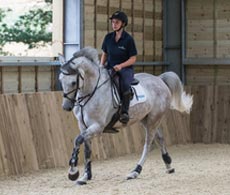
Is your seat affecting your riding?
Did you know that small changes to the way you sit in the saddle can help you become fitter and stronger while riding? Andrea Beattie, an equine coach and trainer who specialises in mindfulness, joined Petplan Equine Ambassador Rachael Barker for a riding lesson and explained three exercises all riders can use to develop a more secure and effective seat.
Why should you consider your seat?
You probably already know that your seat is one of the most important aids when riding. With it you can ask your horse to go forwards, backwards, sideways, stop and alter his pace. ‘Horses are so sensitive they can feel a fly landing on their body. But if a rider is too strong with their aids, their horse can become immune to them,’ says Andrea. So, it follows that by being balanced and secure in the saddle, you won’t rely on the reins to steady yourself and will leave your horse free to move without restriction.
How mindfulness techniques can help
‘Most of us have such busy lives that we live in our minds a lot of the time and aren’t conscious of what our bodies are doing. Being more mindful can help you become aware of subtle shifts during your riding,’ Andrea explains. ‘This not only puts you more in touch with what your body is doing, but also makes you aware of how your movements might be affecting your horse. So, improving your seat can make you a more secure and effective rider. Plus, it can also improve the relationship you have with your horse because you’re communicating more clearly.’
Andrea’s advice for applying mindfulness to your riding is simple: take the time to stop and focus on your breathing. This gives your mind some space, and makes you feel more connected to your body and aware of what it is doing and how it is feeling. She recommends sitting quietly for 10 minutes before riding, closing your eyes and taking deep breaths in through your nose and out through your mouth (as if you are filling your lungs from the bottom up). Once the 10 minutes are over, Andrea advises holding on to this feeling of mindfulness and using it while riding. Here, she shares practical exercises that can help.
Three exercises for a better seat
1. Balancing act
‘Being balanced and equal in the saddle is vital for a good seat,’ Andrea says. ‘We’re all a little one-sided and this can impact how centrally we sit in the saddle, how your horse moves and the effectiveness of aids.’ These movements can help you ensure both sides are equally strong.
Use your muscles equally
One simple exercise you can use to ensure you develop your muscles equally is to alternate which side of your body you use for on-the-ground tasks. ‘When mucking out, we’ll often hold a fork or broom in one hand, which increases the strength in that side, but not the other,’ Andrea explains. ‘By consciously swapping hands you’ll build strength in your weaker side and become more even, which will have a positive effect on how centrally you sit in the saddle. You can do the same when grooming; holding the brush in your left hand when on your horse’s near side and the right hand on your horse’s off side. It will take some practice, but you’ll soon notice the difference.’
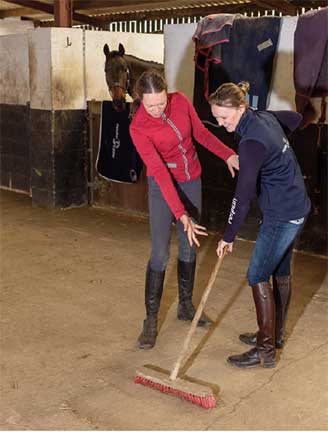
Stretch your hamstrings
‘This is a useful exercise to do before you ride to even out your hamstrings and muscles on both sides of your body. If you have one hamstring shorter than the other, your leg can creep up in the saddle, which will push your seat over to the other side.
‘Stand with your feet together, link your fingers behind your back and gently pull your hands away from your shoulder blades. Next, initially with your knees bent, fold forwards from the waist with your hands towards the sky, and then try to pull your hands down towards the ground over the top of your head. Focus on your breathing during this exercise – deep breaths in and out. As you get more proficient, you can attempt to straighten your legs. You’ll feel the pull on the backs of your legs and hamstrings.’
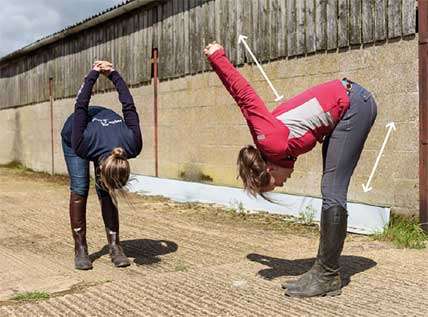
2. Find your seat bones
‘Sit on a chair or a barrel and close your eyes, focusing on your breathing,’ Andrea says. ‘Picture even weight going down through your seat bones. Next, put more weight into your left seat bone and then back to the centre, and then put more weight into the right seat bone before moving to the centre again. This will help you locate your seat bones so that when you are on your horse, you can feel whether you are sitting straight and balanced, and not leaning over to one side.
‘You can also perform the same exercise on your horse so that you are always sitting centrally. Close your eyes and feel where your seat bones are, adjusting them accordingly if they don’t feel equal. You can experiment and see how sensitive your horse is by gently moving your seat bones left and right and seeing if your horse moves in the same direction.’
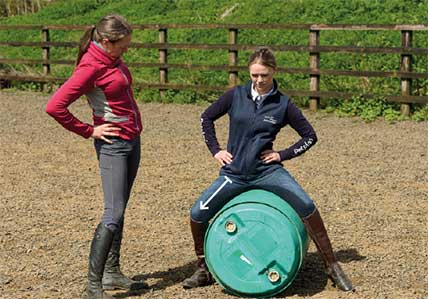
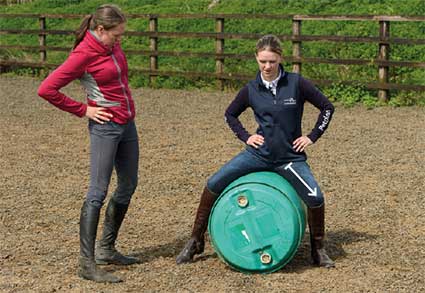
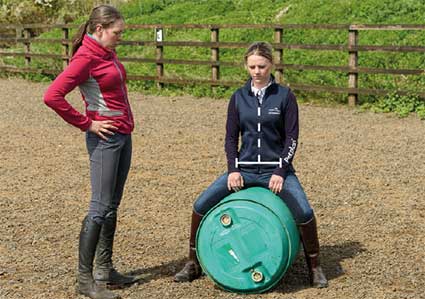
3. Pelvic tilting
Pelvic tilt exercises are subtle spinal movements that strengthen the supporting muscles around the lower back, particularly the abdominals. This exercise can be used both in and out of the saddle.
‘Sit with a straight back either on a chair, barrel or your horse and find your pelvis’s neutral position – whatever feels most comfortable and natural,’ says Andrea. ‘Next, perform an anterior pelvic tilt by taking a deep breath in, relaxing your lower back and allowing your seat bones to sink deeper into the saddle or chair. Draw your tummy towards your back when you sit deeper and gently breath out. Next is the posterior tilt, so take a deep breath in, and as you breathe out, feel as though you are pushing your spine towards your tummy.
‘These movements can also be used when you’re performing transitions. For a downward transition, perform an anterior pelvic tilt, so when you are doing the out breath, you relax and sink into the saddle and your tummy goes towards the spine. When you are doing an upward transition, you perform a posterior tilt, where you lighten your seat by moving your spine towards your tummy, and as you breathe in you ask for the upward transition. Your horse will soon learn what the subtle shifts in your seat mean.’




